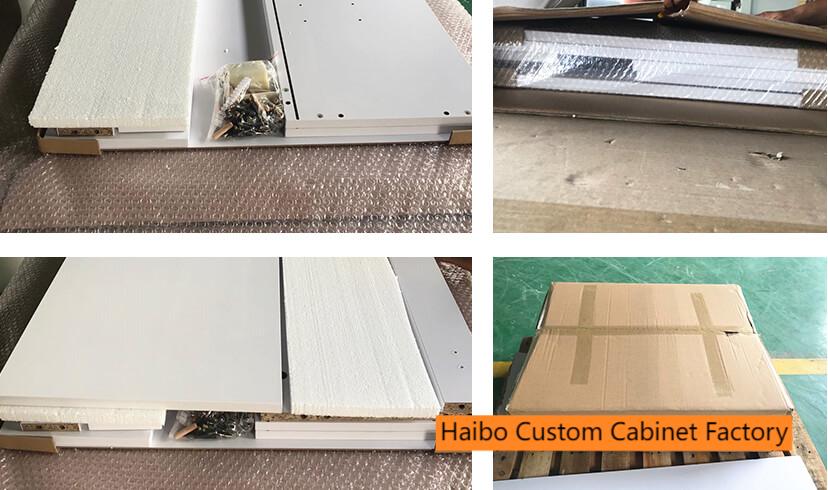Creating custom cabinets is an intricate and rewarding process that combines personal expression, technical precision, and skilled craftsmanship. Unlike standard, mass-produced options, custom cabinets are built to fit your space, match your style, and meet your specific functional needs. Let’s take a comprehensive look into how a Custom Cabinet Factory brings cabinetry to life.

1. The Design and Consultation Phase
Every cabinet begins with a vision. Whether you’re redesigning a kitchen, upgrading a bathroom, or adding functional storage to a unique corner of your home, the journey starts with a design consultation. This phase is essential in setting the tone for the entire project. It involves more than just measurements and sketches—it's about understanding how you live, what inspires your aesthetic, and how the cabinetry will enhance your daily routine. Professional designers from a Custom Cabinet Factory will listen carefully to your needs, evaluate your space constraints, and offer expert suggestions based on current trends, ergonomic principles, and architectural harmony. Their role is to balance form and function while turning your ideas into a feasible and beautiful design.
During the consultation, designers work closely with you to discuss:
• The purpose of the cabinets
• Your design preferences (modern, traditional, rustic, etc.)
• Desired storage features (pull-out drawers, spice racks, hidden compartments)
• Materials and color choices
Measurements of the installation space are taken meticulously to ensure accuracy. Advanced 3D modeling software is often used to create digital renderings that help visualize the final product.
2. Selecting the Right Materials
The next step in the process involves choosing the right materials. A Custom Cabinet Factory will typically offer a wide selection of options including:
• Hardwoods like maple, cherry, oak, walnut, and birch
• Plywood for strength and stability in cabinet boxes
• Medium-Density Fiberboard (MDF) for smooth painted finishes
• Veneers and laminates for a modern, cost-effective appearance
Each material is chosen based on the desired look, durability, and the location where the cabinet will be installed (e.g., moisture resistance for bathrooms).
Finishes play an equally important role. Clients can select from various:
• Wood stains
• Paint colors
• Glazing techniques
• Sheens such as matte, satin, semi-gloss, or high-gloss
Hardware selection is also a key detail. Hinges, drawer slides, knobs, and handles all contribute to the functionality and final look of your custom cabinetry.
3. Engineering and Technical Drawings
Once the design and material selections are finalized, the project transitions into a highly technical phase where precision becomes paramount. Engineers at the Custom Cabinet Factory take the design concepts and transform them into fully detailed technical drawings. This phase serves as the blueprint for everything that follows in the manufacturing process. Using specialized CAD software, engineers map out every dimension, cut, joint, and component location, ensuring no detail is overlooked.
Below is a sample overview of the key components included in engineering documentation:
| Component | Description |
|---|---|
| Cabinet Dimensions | Overall height, width, and depth of each cabinet unit |
| Cut Lists | Exact measurements for each panel and part to be cut |
| Assembly Instructions | Step-by-step process for constructing each cabinet section |
| Hardware Placement | Specific locations for hinges, drawer slides, and handles |
| Joinery Techniques | Details on how parts are connected (e.g., dovetail, dowels) |
| Material Allocation | Assigned materials for each component |
These technical plans ensure that every component is cut to exact specifications and fits together flawlessly during assembly. They also help prevent material waste, speed up production, and support the seamless coordination between departments, from machining to finishing. Precision at this stage minimizes the risk of errors and ensures that the final product will not only look great but function as intended within the space. By investing time in meticulous engineering, a Custom Cabinet Factory sets the foundation for excellence and customer satisfaction.
4. Precision Manufacturing
The manufacturing phase begins with cutting and shaping raw materials. Modern factories use a blend of traditional woodworking and advanced CNC machinery to achieve precise cuts and intricate detailing.
Key manufacturing steps include:
• Cutting panels and components using saws and routers
• Drilling holes for shelf pins, hardware, and assembly
• Edge banding for a finished appearance on visible edges
• Joining panels using dovetail, dado, mortise-and-tenon, or dowel joinery techniques
Because it’s a custom process, each cabinet is built to order. Craftsmen assemble each piece with great attention to detail, ensuring alignment, strength, and flawless fit.
5. Sanding and Finishing
The sanding and finishing stage is vital for ensuring both the aesthetic appeal and durability of the wooden door. This process involves several key steps:
• Sanding Procedure
Sanding begins with coarse-grit sandpaper to smooth out rough surfaces and remove any machine marks. It progresses to finer grits (e.g., 180–240) to prepare the surface for finishing. Careful attention is paid to edges, panels, and intricate carvings to avoid flattening profiles or leaving swirl marks.• Surface Preparation Techniques
After sanding, the surface is cleaned using compressed air or tack cloths to remove all dust particles. In some cases, a wood conditioner or sealer is applied to ensure even absorption of the finishing materials.• Coating Process
The door is then treated with one or more layers of primer, stain, or paint, depending on the desired final look. Water-based and solvent-based finishes may be used based on the material type and performance requirements. Each coat is followed by light sanding to maintain a smooth surface.• Finishing Application
A topcoat—such as lacquer, polyurethane, or UV-cured finish—is applied to protect the door from moisture, scratches, and UV damage. The choice of finishing product affects the door’s sheen (matte, satin, or gloss) and tactile quality.• Curing and Drying
Once the final coat is applied, the door undergoes a controlled curing process. Depending on the finish type, this may involve air-drying, heat-assisted drying, or UV curing. Proper curing ensures the finish fully hardens, enhancing scratch resistance and long-term durability.
Each of these steps is carefully monitored to meet quality standards and ensure that the wooden door leaves the production line with a professional-grade surface finish that is visually appealing and built to last.
6. Quality Control and Final Assembly
Before leaving the Custom Cabinet Factory, each cabinet goes through a rigorous quality control process designed to ensure long-lasting performance, visual consistency, and customer satisfaction. Skilled technicians carefully inspect every component—from the integrity of joints and alignment of doors to the smoothness of surfaces and precision of finishes. Any imperfections, such as scratches, uneven paint, or misaligned hardware, are identified and corrected immediately. This meticulous attention to detail ensures that each cabinet not only meets but exceeds industry standards. The goal is to deliver a flawless product that reflects the craftsmanship and reliability our clients expect.
Inspectors check:
• Dimensional accuracy
• Surface finish consistency
• Hardware alignment
• Door and drawer functionality
Any imperfections are corrected on the spot. In many factories, drawers are pre-assembled, and doors are pre-hung to save time and reduce installation errors on-site.
7. Safe Packaging and Delivery
After each custom cabinet successfully passes final quality inspection, the next crucial step is packaging and preparing the units for safe delivery. This stage ensures that all the hard work—from design to finishing—is not compromised during transportation. Cabinets are typically delicate and susceptible to scratches, dents, and warping if not properly protected, so the Custom Cabinet Factory employs a multi-layered protection strategy.
-
Each cabinet is first wrapped in a protective foam layer or bubble wrap to shield the surfaces from abrasion. Corners, being the very vulnerable areas, are reinforced with durable cardboard or molded plastic corner guards. For added stability, shrink-wrap or stretch film is tightly secured around the entire cabinet unit to prevent movement and keep protective materials in place.
-
In many cases, customized foam or padded inserts are used to cushion internal components, such as doors, drawers, and shelving, especially for larger or more intricate pieces. Cabinets are then labeled clearly according to room assignment and installation sequence, allowing for an organized unloading and installation process on-site.
-
All units are loaded into transport vehicles using padded lifts or racks, and the trucks are climate-controlled when necessary to avoid damage from temperature or humidity changes during delivery.

8. Professional Installation
The final step is installation. Professional installers transport the cabinets to your home and begin the fitting process. Walls and floors are checked for level, and shims are used where necessary to ensure a nice fit.
Installers secure each unit in place, align doors and drawers, adjust hinges, and complete any trim or filler panel installation. Final touches like caulking and sealing may be applied for a polished appearance. Depending on the size and complexity of the project, installation can take anywhere from a day to a week.
Why Choose a Custom Cabinet Factory?
There are many advantages to choosing custom cabinetry from a reputable Custom Cabinet Factory:
• Tailored Fit: Cabinets are designed for your unique space, avoiding awkward gaps or fillers.
• Personalized Design: You choose the style, materials, and features to match your home.
• Superior Craftsmanship: Skilled artisans and high-end machinery ensure quality and longevity.
• Innovative Solutions: Hidden storage, corner optimizations, and built-in appliances can be integrated seamlessly.
Custom cabinets elevate the value and visual appeal of your home while providing functional storage solutions that suit your lifestyle.
Sustainability in Custom Cabinet Manufacturing
Modern Custom Cabinet Factories are increasingly adopting sustainable practices, including:
• Using FSC-certified wood
• Implementing dust and waste collection systems
• Recycling wood scraps and packaging
• Choosing low-VOC finishes and adhesives
Eco-conscious consumers can also opt for reclaimed materials or bamboo, a fast-growing renewable resource.
Common Types of Custom Cabinets
Depending on the area of the home, custom cabinets can take many forms:
-
• Kitchen Cabinets: Base cabinets, wall cabinets, pantries, and islands
-
• Bathroom Vanities: With integrated sinks and moisture-resistant materials
-
• Entertainment Units: Designed for TVs, speakers, and storage
-
• Office Cabinetry: Desks, filing cabinets, and built-ins
-
• Closet Systems: Wardrobes, shelving, and shoe racks
Each type comes with its own considerations for hardware, finish, and interior configuration.
Customization Options Worth Exploring
Custom cabinet designs can include:
Soft-close hinges and drawers
Built-in lighting (LED strips, puck lights)
Pull-out shelves and organizers
Appliance garages
Touch-latch or push-to-open systems
Glass-front or open shelving
Integrated charging stations
These features not only improve usability but also contribute to the uniqueness of your space.
- From Vision to Reality
The journey of building custom cabinets from a professional Custom Cabinet Factory is a collaboration of design vision, technical planning, material excellence, and skilled execution. Each step—from initial consultation to final installation—is handled with precision to ensure the final product meets your expectations.
Whether you're revamping your kitchen, updating a bathroom, or optimizing your living space, Haibo's custom cabinetry offers a timeless, practical, and beautiful solution. With countless options for customization and a factory committed to quality, your cabinetry project is an investment in both form and function.

 English
English русский
русский Français
Français Español
Español bahasa Indonesia
bahasa Indonesia عربى
عربى



